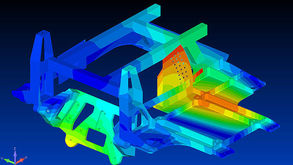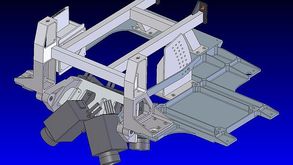CAE Engineering
Global competition and the increasing demands for functionality, cost effectiveness, and time-to-market require technology oriented industries to critically question traditional approaches in order to open new domains and to develop better, more innovative solutions. In this process of reorientation new tools such as computer aided engineering (CAE) represent a decisive component to supplement and support proprietary know-how.
In recent years SI has become a specialist in the development and optimization of critical systems, parts, and structures by using modern CAE tools. The successful realization of development projects with distributed tasks is dependent upon close communication between the project partners and the engagement of highly skilled engineers. Both conditions which are fulfilled by SI in an optimal way as demonstrated by our many successfully completed projects.
Concept - Design - Optimization
In the early stages of the conceptual phase, the future function and development costs of a product are determined.
Mistakes made in these initial stages are either irreversible, or can only be corrected later at a high technical and financial cost. Using the CAE simulation models allows for early detection and prevention of conceptual mistakes and weaknesses in construction.
SI solves all development problems by the use of leading CAE design and simulation software. As a result 3D CAD- and FEA-models, manufacturing and assembly drawings, as well as parts lists, are available.
The conventional approach to the design of parts is based on empirical know-how and is generally adequate only for one special load situation. In many cases testing parts to identify malfunctions and deficiencies does not provide the required insight to explain a technical problem so that the trial-and-error method must be used to improve a part. Unfortunately, such an approach leads to long development time, high development cost, and uncertain feasibility. As soon as a part is subject to different and maybe even contrary load situations, the empirical approach is no longer adequate in finding an acceptable solution in a reasonable amount of time.
SI uses CAE simulation programs during the entire development process to identify the critical characteristics of a part and to optimize them at an early stage of development. Thus, the need for redesign is reduced to a minimum. The use of CAE simulation programs identifies existing stresses, strains, deformities, temperature distributions, natural frequencies, and flow fields a long time before the first prototype is built. Optimization not only guarantees the form, fit and function of a part, but also leads to lighter weight and higher durability.
With extensive background in the aerospace industry, SI engineers have many years of experience in the development of composite structures. In addition to their use in the aerospace industry, composites are increasingly being used in related technological fields. While they offer the greatest strength at the least amount of weight, their use must also be tailored to take full advantage of all their benefits.
In cases where composites are built using an autoclave, not only the parts but also the moulds and jigs must be optimized to compensate for shrinkage and deformity during the cooling phase. In such cases SI can give valuable support based on our experience in the use of simulation tools.
FEM-Structural Analysis
Since more than two decades Structural Analyses and Optimizations are offered by SI in the following areas:
Dynamics
- Natural frequencies/Natural modes
- Harmonic stresses and strains
- Harmonic amplitudes of oscillations
- Time-dependen stresses and strains
- Time-dependent deformations
- Collisions
Composites
- Laminate failure
- Matrix failure
- Honeycomb failure
- Stresses and strains
- Fibre angle optimization
Buckling
- Buckling of structures
- Postbuckling
Thermal analyses (steady/unsteady)
- Heat transfers
- Temperature distributions
- Thermal stresses
Linear and nonlinear statics
- Proof of strength
- Stresses and strains
- Deformations



